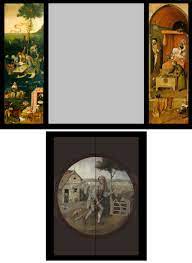
Hartau 2005
“Das neue Triptychon von Hieronymus Bosch als Allegorie über den >>unnützen Reichtum<<” (Johannes Hartau) 2005
[in: Zeitschrift für Kunstgeschichte, Band 68 (2005), Heft 3, pp. 305-338]
Thanks to infrared photography and dendrochronological research, we can now be sure that the Ship of Fools panel (Paris), the Gula fragment (New Haven), the Death of a Miser panel (Washington), and the Pedlar tondo (Rotterdam) originally belonged to one and the same triptych, the central panel of which has been lost. This triptych, produced in the years after 1486, was an allegory on prodigal licentiousness and greed. The left interior panel (Ship of Fools + Gula) focuses on Luxuria (mixed with Gula), whereas the theme of the right interior panel (Death of a Miser) is Avaritia. What we know today as the Rotterdam Pedlar tondo, was once the exterior of the triptych. The pedlar painted by Bosch is an ambivalent figure. Does he represent mankind addicted to the vanities of the world, or is he a pilgrim of life who has left his sinful past behind and is now on his way to eternal bliss? The exterior panels of the Haywain triptych (Madrid) also show a pedlar. According to Hartau, both pedlars are warning figures: they are probably repentant sinners, and in spite of their sinful past they can still hope for Salvation on their way to the Hereafter (represented by a gate and a peaceful cow in Rotterdam, by an unreliable little bridge in Madrid). But it remains doubtful whether they will indeed be saved.
Thematically, the Haywain triptych is a further development of what Hartau calls the New Triptych (Neue Triptychon). Both paintings warn of sensual enjoyment and greed, but the Haywain adds an eschatological dimension, not only through the left and right interior panels, but also by means of a Christ figure showing His wounds to an apparently uninterested world, a warning Isaiah figure, and a reference to the legend of the red Jews. At the end of this essay, Hartau asks the question of what the lost central panel of the New Triptych may have represented: another haywain or something completely different? Hartau’s earlier suggestion that it represented a Wedding at Cana (see Hartau 2003) has here been hidden in a short footnote. Regarding the supposed ambivalence of Bosch’s pedlars, it is striking that Hartau does not spend one single word on the allegorical implications of the fact that both pedlars are keeping a growling dog at distance by means of a stick.
[explicit 3 January 2023]